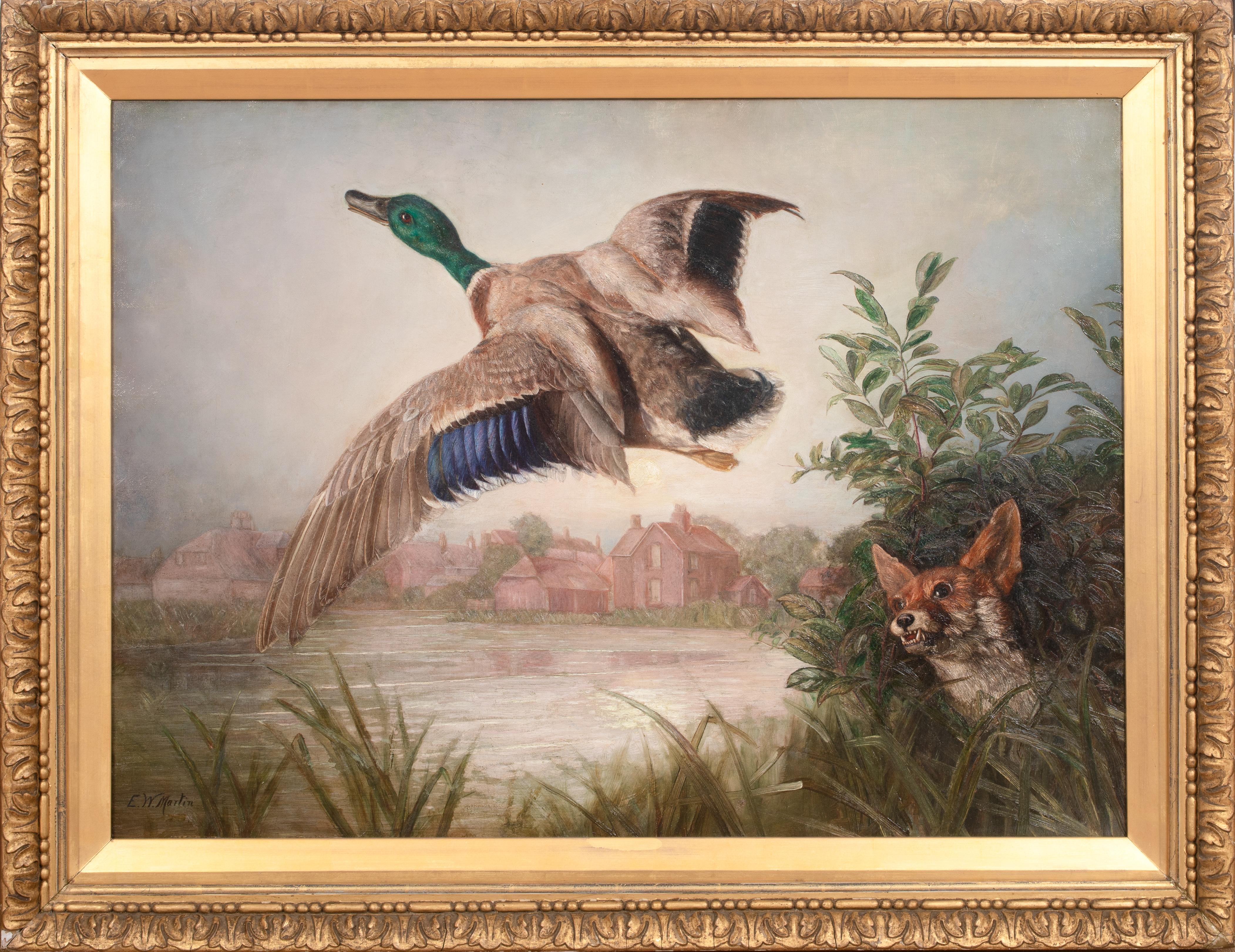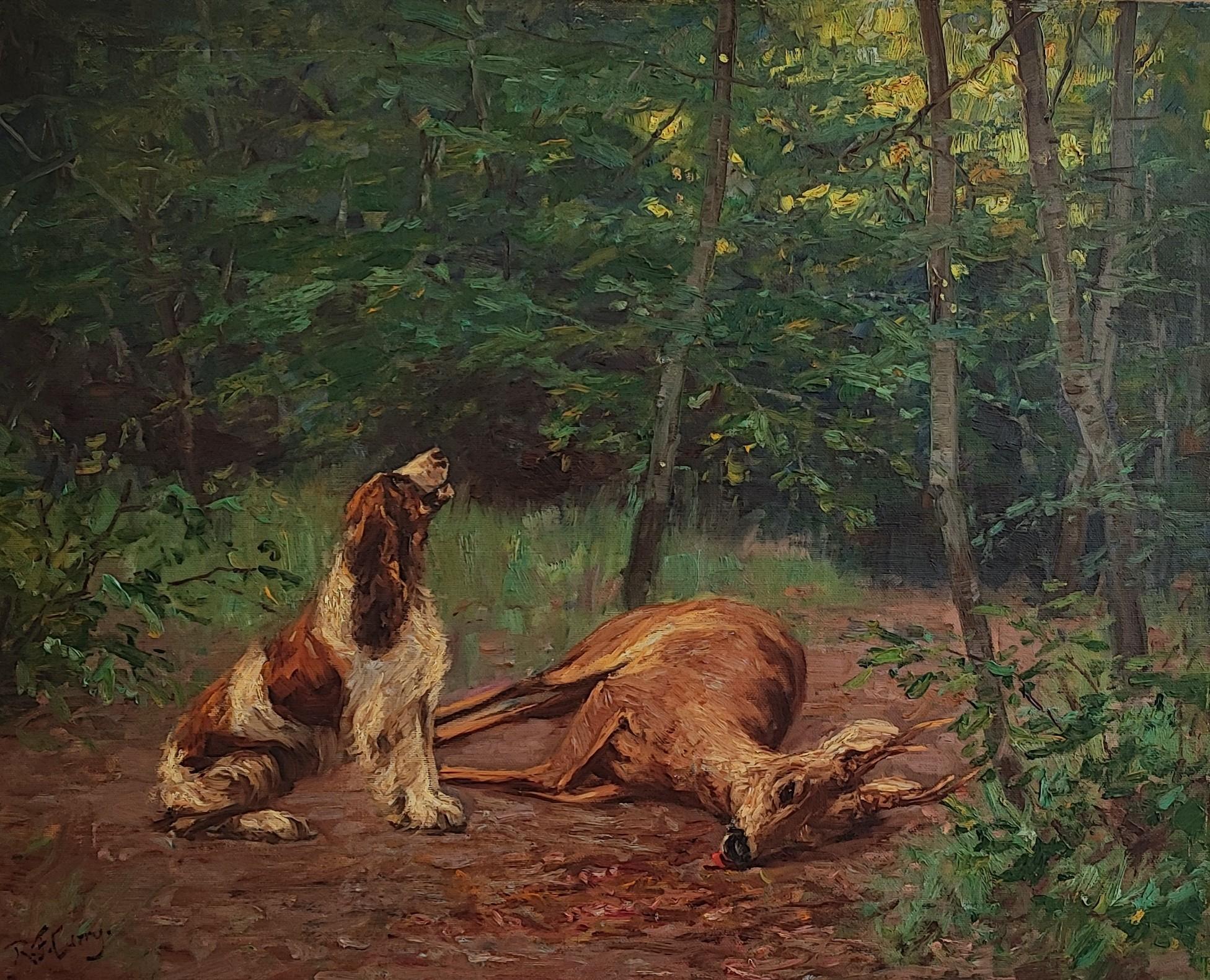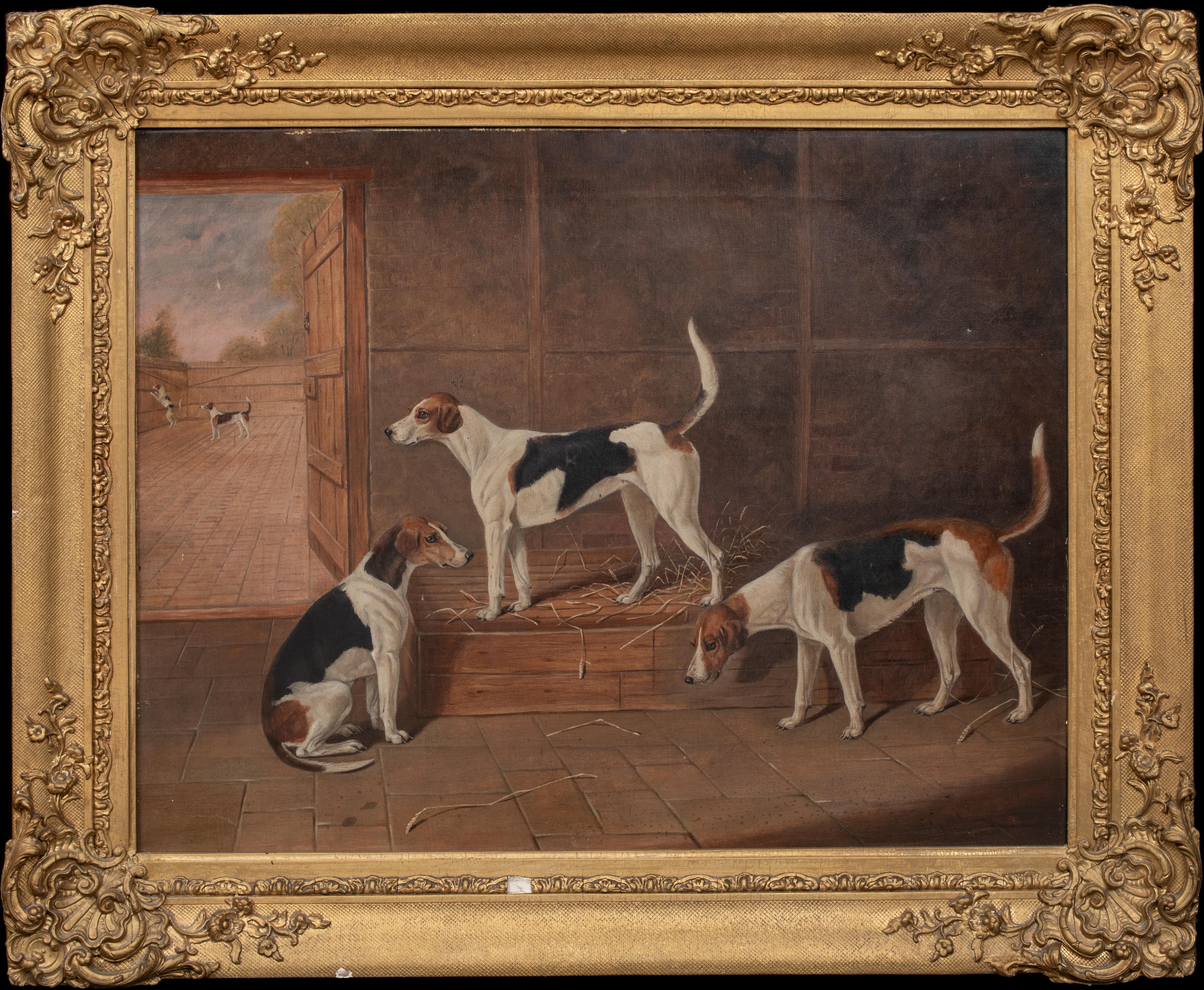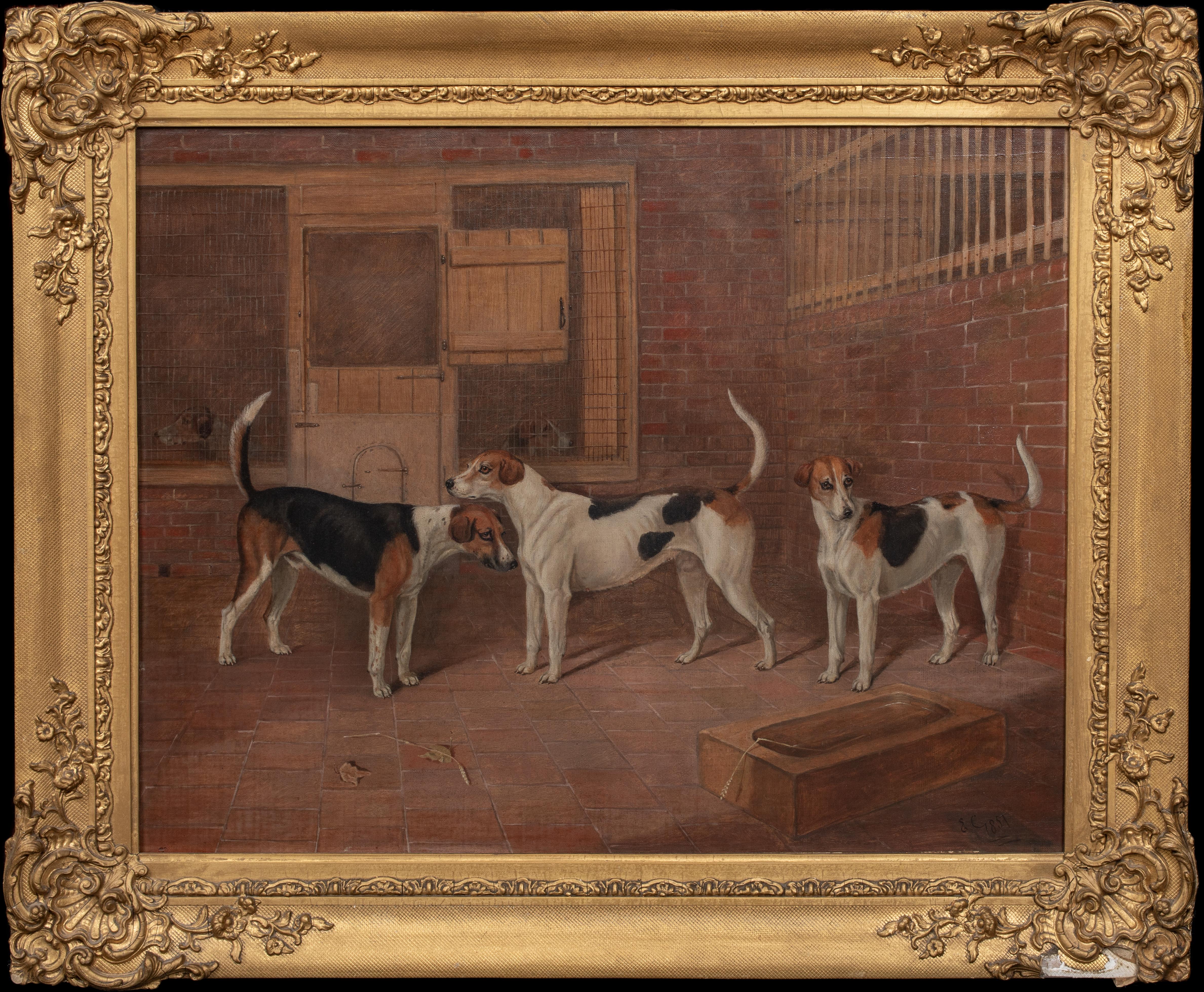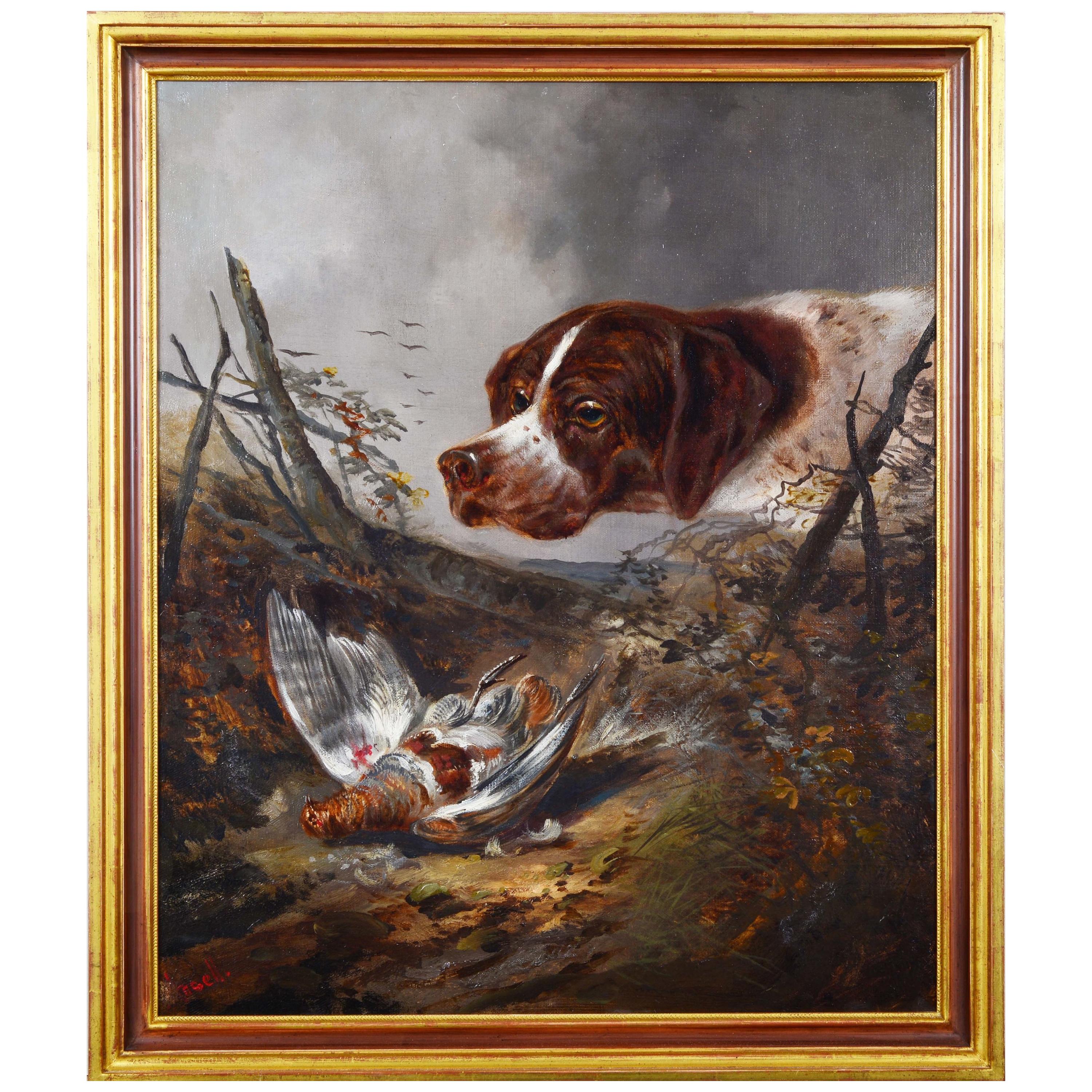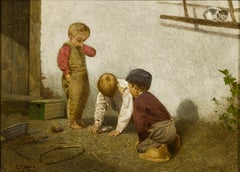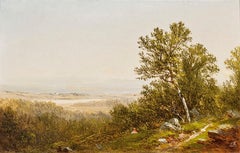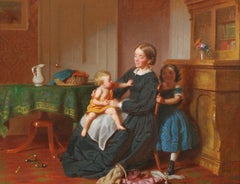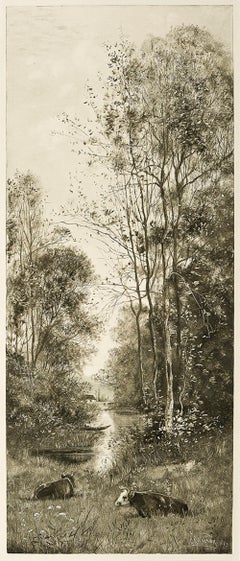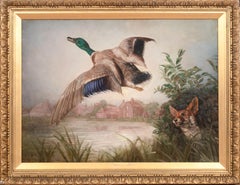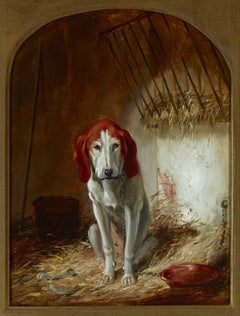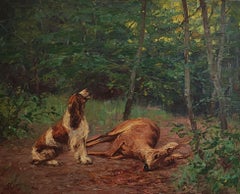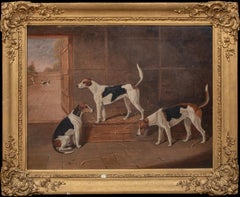Items Similar to The Intruder
Want more images or videos?
Request additional images or videos from the seller
1 of 8
Arthur Fitzwilliam TaitThe Intruder1864
1864
$150,000
£113,200.88
€129,597.89
CA$211,549.73
A$232,255.22
CHF 121,168.04
MX$2,810,611.53
NOK 1,518,653.37
SEK 1,430,970.75
DKK 967,413.65
About the Item
Arthur Fitzwilliam Tait was born at Livesey Hall, near Liverpool, England, and began his career as a clerk at the gallery of Agnew & Zanetti’s Repository of Arts in Manchester. While there, he developed an interest in studying drawing, and he eventually became a teacher, lithographer, and draftsman. Through the influences of English sporting artists Edwin Landseer, Richard Ansdell, and William Huggins, Tait devoted himself exclusively to sporting painting. Upon his arrival in America in 1850, the artist began to develop a more naturalistic style.
Tait discovered the Adirondacks and the wide variety of animal life that inhabited its regions in 1852. The course of his career made an immediate turn at this point, as the plentiful opportunities for camping, sketching, and sporting afforded him by the rugged and untamed Adirondack landscape proved to be irresistible. Through his summers in the Adirondack Mountains, Tait became an avid outdoorsman, and participated in many of the activities he depicted in his paintings. Tait maintained a studio in New York, but at every opportunity he left for the Adirondacks, staying variously at Chateaugay and Loon Lake. Tait eventually found a number of ready buyers for his work. By the early 1860s, he moved out of New York to the suburb of Morrisania, thanks to the number of works of his sold by prominent New York art dealers, such as Samuel P. Avery and Michael Knoedler. In 1866, a single auction of 69 of his works earned him over $6,000, and later that year he established a long-term relationship with Louis Prang, who, along with Currier & Ives, sold a number of lithographs of Tait’s images over the years.
Beginning in 1860, Tait began to spend time on what is now called Antlers Point on Raquette Lake. By 1870, Tait was frustrated with the burgeoning tourism of the area, and he began to vacation instead on Long Lake, where he established a year-round residence from 1874 to 1877. He returned to the Raquette Lake area often, however, and some of his best works were painted there. When his first son was born in 1876, Tait devised a floating studio so that he could escape the rigors and distractions of his home life, and leave for several days at a time. From his waterborne cabin, Tait made detailed studies of the local fauna, which he observed at length with a telescope, and he sketched and painted from nature endlessly. By 1877, Tait returned to New York, but still returned frequently to his house on Long Lake. In 1880, his wife died during the birth of their second child, and her half-sister, who soon married Tait, did not enjoy life in the mountains. In 1882, Tait sold his Long Lake house, thus closing the Adirondack chapter of his life.
Tait was particularly productive in the year of 1864. In his checklist of the artist’s work, Henry F. Marsh records seventy-eight oil paintings from that year, including The Intruder (Cadbury and Marsh, loc. cit.). Several of these works include spaniels and woodcocks, as does the present painting.
The Intruder bears a strong resemblance to the work of the great British animal painter, Sir Edwin Landseer. As Warder H. Cadbury has written:
In this century Tait has occasionally been called by journalists the Landseer of America in a well-intentioned tribute to his talent as an animal painter. However, since both artists painted many canvases of deer, it is important not to mistake Landseer’s influence upon Tait’s style. . . . From the start [Tait] eschewed the anthropomorphic melodrama, pathos, humor, sentimentality, and metaphysical allegory that characterized so much of Landseer’s popular work. According to family tradition, Tait admired Landseer’s genius but felt that he “prettied” his animals too much. Tait’s debt to him may have been largely economic; by popularizing animal and sporting art throughout the English-speaking world, Landseer helped create a market for Tait’s canvases with similar themes but a quite different manner (ibid., p. 18).
The early provenance of the present painting was recorded by Tait in his register of paintings, which reads: “[No.] 328. Cocker Spaniel & 3 Woodcock 20 x 14 on panel. Williams & Everett” (ibid., p. 245). Tait had maintained a strong relationship with the Williams & Everett gallery in Boston since about 1863, the year before the present picture was painted. That year, the gallery sold seven of Tait’s works, followed by seventeen in 1864, possibly including the present painting. Williams & Everett, the only free gallery in Boston, provided Tait a foothold in the Boston market for many years.
- Creator:Arthur Fitzwilliam Tait (1819-1905, American)
- Creation Year:1864
- Dimensions:Height: 13.75 in (34.93 cm)Width: 20 in (50.8 cm)
- Medium:
- Movement & Style:
- Period:
- Condition:
- Gallery Location:New York, NY
- Reference Number:Seller: APG 85001stDibs: LU234656152
About the Seller
5.0
Recognized Seller
These prestigious sellers are industry leaders and represent the highest echelon for item quality and design.
Established in 1952
1stDibs seller since 2010
35 sales on 1stDibs
Typical response time: 7 hours
Associations
Art Dealers Association of America
- ShippingRetrieving quote...Shipping from: New York, NY
- Return Policy
Authenticity Guarantee
In the unlikely event there’s an issue with an item’s authenticity, contact us within 1 year for a full refund. DetailsMoney-Back Guarantee
If your item is not as described, is damaged in transit, or does not arrive, contact us within 7 days for a full refund. Details24-Hour Cancellation
You have a 24-hour grace period in which to reconsider your purchase, with no questions asked.Vetted Professional Sellers
Our world-class sellers must adhere to strict standards for service and quality, maintaining the integrity of our listings.Price-Match Guarantee
If you find that a seller listed the same item for a lower price elsewhere, we’ll match it.Trusted Global Delivery
Our best-in-class carrier network provides specialized shipping options worldwide, including custom delivery.More From This Seller
View AllHis Only Pet
Located in New York, NY
Charles Caleb Ward was born in St. John, New Brunswick, Canada, the grandson of a New York Ward who had left for New Brunswick around the time of th...
Category
Late 19th Century American Realist Paintings
Materials
Oil, Board
Figure in a Landscape
By David Johnson
Located in New York, NY
Signed (at lower right): DJ [monogram]; (on back): David Johnson 1865
Category
Mid-19th Century American Realist Landscape Paintings
Materials
Oil, Board
Peek-a-Boo
By Seymour Joseph Guy
Located in New York, NY
In the latter half of the nineteenth century and into the first decade of the twentieth, New York City art aficionados could count on finding recent work of Seymour Joseph Guy hanging on the walls of the city’s major galleries. Primarily a genre artist, but also a portraitist, between 1859 and 1908 Guy showed more than seventy works at the National Academy of Design. From 1871 to 1903 he contributed over seventy times to exhibitions at the Century Club. From 1864 to 1887, he sent about forty pictures to the Brooklyn Art Association. A good number of these works were already privately owned; they served as advertisements for other pictures that were available for sale. Some pictures were shown multiple times in the same or different venues. Guy was as easy to find as his canvases were omnipresent. Though he lived at first in Brooklyn with his family and then in New Jersey, from 1863 to his death in 1910 he maintained a studio at the Artist’s Studio Building at 55 West 10th Street, a location that was, for much of that period, the center of the New York City art world.
Guy’s path to a successful career as an artist was by no means smooth or even likely. Born in Greenwich, England, he was orphaned at the age of nine. His early interest in art was discouraged by his legal guardian, who wanted a more settled trade for the young man. Only after the guardian also died was Guy free to pursue his intention of becoming an artist. The details of Guy’s early training in art are unclear. His first teacher is believed to have been Thomas Buttersworth...
Category
19th Century American Realist Figurative Paintings
Materials
Canvas, Oil
$110,000
Brookside
Located in New York, NY
Signed (at lower right): C A Walker
Category
Late 19th Century American Realist Landscape Prints
Materials
Monotype
Chestnut Racehorse with a Jockey Up On a Training Strap
By Henry H. Cross
Located in New York, NY
It was Henry Cross's portraits of horses belonging to the prominent breeders and trainers of the second half of the nineteenth century that won the artist renown as an animal painter. Born and raised in upstate New York, Cross's proficiency in both drafting and caricature was revealed while he was still a student at the Binghamton Academy, New York. In 1852, when he was only fifteen years old, Cross joined a traveling circus that took him to Minneapolis, Minnesota, and to the first of many Indian encampments that he would draw upon for subject matter throughout his career. Biographers differ as to the year Cross left for Europe, however, he was in Paris from 1852 to 1853 or 1854, where he studied with Rosa Bonheur, a highly esteemed French painter of horses. Upon Cross's return to the United States he was commissioned to paint the studs of wealthy horsemen, including those of Commodore Cornelius Vanderbilt, Robert Bonner, the owner-publisher of The New York Ledger, and "Copper King" Marcus Daly, whose 18,000 acre stock farm was reputed to be the greatest and most valuable horse ranch in the world.
Although Cross received the highest pay of any equine artist of his day (up to $35,000. for one order, according to The Horse Review of April 10, 1918, p. 328), he frequently joined traveling circuses and painted the locales where they visited. He also painted portraits of notable contemporaries, such as President Abraham Lincoln, ex-president Ulysses S. Grant, King Edward VII of England, W. F. "Buffalo Bill...
Category
19th Century American Realist Animal Paintings
Materials
Canvas, Oil
Still Life in a Landscape
By Paul LaCroix
Located in New York, NY
Oil on canvas
Category
19th Century Still-life Paintings
Materials
Oil
You May Also Like
A Lucky Escape, 19th Century by Edward William Martin (19th Century British)
Located in Blackwater, GB
A Lucky Escape, 19th Century
by Edward William Martin (19th Century British)
Large 19th Century English portrait of a Duck flushed out of the reeds by a fox, oil on canvas by Edwar...
Category
19th Century Animal Paintings
Materials
Canvas, Oil
The Hound
By Arthur Fitzwilliam Tait
Located in Bryn Mawr, PA
Oil on board
Signed within painting (on bucket): AFT
Provenance
Private collection
Why We Love It
Tait’s animal paintings were hailed for their masterful realism. Moreover, he capt...
Category
Mid-19th Century Realist Animal Paintings
Materials
Oil
Dog and fawn
By Robert Franz Curry
Located in Genève, GE
Work on canvas
Category
Mid-20th Century American Realist Animal Paintings
Materials
Oil
Paradox Primrose & Princess, 19th Century by EDWARD CORBET (1815-1899)
Located in Blackwater, GB
Paradox Primrose & Princess, 19th Century
by EDWARD CORBET (1815-1899)
Large 19th Century portrait of New Forest Foxhounds Paradox Primrose and Princess, oil on canvas by Edward C...
Category
19th Century Animal Paintings
Materials
Canvas, Oil
Shiner Primrose & Princess, 19th Century by EDWARD CORBET (1815-1899)
Located in Blackwater, GB
Shiner Primrose & Princess, 19th Century
by EDWARD CORBET (1815-1899)
Large 19th Century portrait of New Forest Foxhounds Shiner Primrose and Princess, oil on canvas by Edward Cor...
Category
19th Century Animal Paintings
Materials
Canvas, Oil
Hunting Scene by German Painter, End of 19th
Located in Roma, IT
Oil on canvas by a German Painter whose signature is on canvas by is not readable.
Beautiful example of hunting scene.
Measures with frame: CM 67.5 x 3.5 x 58
Signed by the artist...
Category
Antique Late 19th Century German Paintings
Materials
Canvas
More Ways To Browse
Antique Avery
Cocker Spaniel
Hunt Slonem Green
Hunt Slonem Purple
Joan Breckwoldt
Springer Spaniel
Canary Painting
Colorful Horse Painting
Jack Russell Terrier
Longhorn Painting
Longhorn Paintings
Pig Oil Painting
Poodle Painting
Scottish Animal Paintings
Tiger Art Pop Art
White Raven
British Painting Of Horse
British Sporting Paintings
